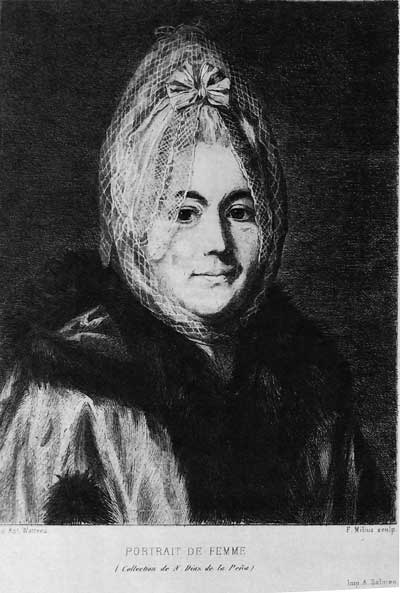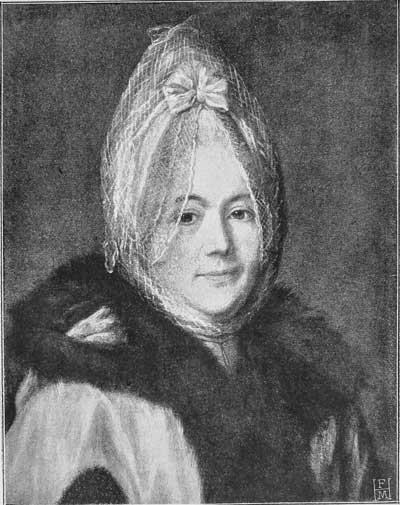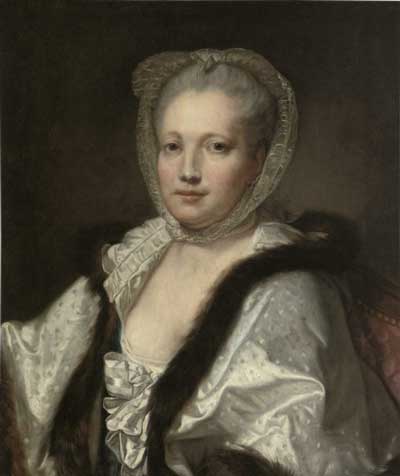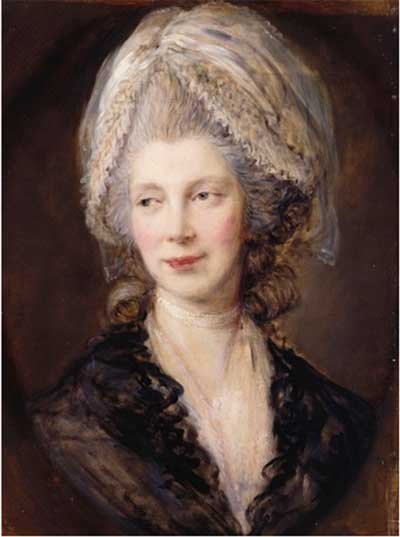
- Home Page
- Accepted
Paintings & Copies - Doubtful
Attributions - Doubtful Textual References
- Alternative
Titles - Collectors &
Museums - Bibliography
- Search Abecedario
- Watteau &
His Circle
X. Femme à la robe fourrée
Entered January 2017
Whereabouts unknown
Oil on canvas
52 x 42 cm
RELATED PRINTS

Félix Milius after “Watteau,” Portrait de femme, etching, 1877.
An etching after this portrait was commissioned from Félix Augustus Millius (1843-1894) by the editors of L’Art, the influential French magazine that was a leading supporter of the Rococo revival. The etching appeared in an 1877 issue apropos of the Diaz sale.
PROVENANCE
Paris, collection of Narcisse Virgilio Diaz de la Peña (1807-1876; artist). His sale, January 22-27, 1877, lot 394: “ÉCOLE FRANÇAISE . . . Portrait de femme. Haut., 53 cent.; larg., 41 cent.” Although the painting was presented as an anonymous work, the report of the Diaz sale in L’Art notes that the owner believed it to be by Watteau, and that the portrait sold to baron Beurnonville for 1,850 francs.
Paris, collection of the baron Etienne Edmond Martin de Beurnonville (1825-1906). His sale, Paris, May 1881, lot 195: “ÉCOLE FRANÇAISE (XVIIIe SIÈCLE) . . . Portrait de Femme. De face, coiffée d’un bonnet de dentelles à noeud rose sur le front, les épaules couvertes d’une pelerine blanche bordée de fourrure noire.
Ce superbe portrait provient de la vente de Diaz qui la tenaît en haute estime. Bien qu’on ne soit pas encore fixé en toute certitude sur le nom de son auteur, il peut à bon droit passer pour une des oeuvres les plus remarquables de l’art français au XVIIIe siècle. Toile. Haut., 53 cent.; larg., 42 cent.”
According to an annotated copy of the catalogue in the Rijksbureau voor kunsthistorische documentatie, the painting sold for 2,120 francs to Malinet.Paris, collection of Yolande Marie Louise (Mrs. Lyne) Stephens (1812-1894; ballerina and wife of the richest commoner in England). Her sale, Paris, Hôtel Drouot, May 9-17, 1895, cat 367: “ANTOINE WATTEAU. . . . A LADY, in white fur-trimmed robe, lace head-dress decorated with pink ribbons / 21½ in. by 17¼ in.”According to an annotated copy of the catalogue in the Rijksbureau voor kunsthistorische documentatie, the painting sold for 278.5 francs to Wertheimer.
London, with Asher Wertheimer (1843-1918, art dealer). The annotated catalogues of the 1895 Lyne Stephens sale record the purchaser’s name as “Wertheimer.” This cannot be Samson Wertheimer (c. 1811-1892) who had died a few years previously but, undoubtedly, his son who took over the business. Two catalogues in the Rijksbureau record slightly different prices: £278.5 and £256.
Paris, collection of Jules Porgès (1839-1921; diamond merchant). Sold in 1897 for £10,800 to Sedelmeyer, according to Adhémar, but it has not been possible to confirm this sale.
Paris, Sedelmeyer Gallery. Illustrated Catalogue of the Fourth Series of 100 Paintings by Old Masters (Paris, 1897), lot 75: “WATTEAU (ANTOINE) . . . Portrait of a Young Lady / Turned to the right, looking at the spectator, dressed in white, fur trimmed robe, and lace headdress with pink ribbons. Bust. Life-size. Canvas, 20 ½ in. by 17 ¼ in. From the Collection of Mrs. Lyne Stephens, London, 1895. M. Jules Porgès. Paris.”
Collection of J. B. Bing, bought in 1898 for £1,700, according to Adhémar.
SELECT BIBLIOGRAPHY
“Chronique de l’Hôtel Drouot” (1877), 117.
Adhémar, Watteau (1950), cat. 286.
REMARKS
This portrait was well regarded in the second half of the nineteenth century, at least by the art market, but it was ignored by Watteau scholars. It then fell from grace. It went unmentioned in the first half of the twentieth century and was cited only once more, in 1950, when Adhémar classified the portrait under “École de Watteau, douteux, incertains,” and wrote that the attribution was undoubtedly wrong. This portrait has remained singularly absent from the Watteau literature, and rightly so.
Despite the longtime association with Watteau, the woman’s costume seems to date well after his lifetime. The type of fur-trimmed border to the gown and the thin veil over the head, pulled back at the center, were popular in the mid- and late eighteenth century. These elements of high fashion can be seen in several Greuze portraits, such as one sold in London, Christie’s, April 25, 2007, lot 183, and another, a portrait of the marquise Marie Angélique de Varenne, Madame George Gougenot de Croissy, painted c. 1757, now in the collection of the New Orleans Museum of Art. The type of veiled head covering, pulled back and revealing the central part in the coiffure, as well as rising to a point at the back, is seen in Gainsborough’s portrait of Queen Charlotte, painted in 1782.


